It’s Sunday morning and you’re sitting in your cozy kitchen, sipping on your favorite steamy cup of tea or coffee, and pondering the day ahead. The sun is shining through your window, casting a warm glow on the dog snoozing at your feet. The world is quiet, for just a moment, and everything feels right. But there’s one thing missing from this idyllic morning: a warm, spongy, gluten-free muffin to enjoy with your drink. But bakers beware: making gluten-free baked goods isn’t quite the same as making their gluten-filled counterparts. Over the years, I’ve learned a thing or two about the tricks, tips, and common pitfalls of gluten-free baking, and today, I want to share with you the why and how of it all.
Now I know what you might be thinking: “Claire, I’ve been down this road before. I followed a gluten-free recipe to the letter, only to end up with a brick instead of a loaf of bread, or cookies that crumbled into dust the moment I tried to pick them up!” Trust me, I get it. Gluten-free baking can be a bit of a Goldilocks situation. Too much of one ingredient and your baked goods are too tough or rubbery. Not enough of another and they fall apart at the seams. But fear not, dear reader — I’m here to help you understand what’s going wrong, and how you can perfect your gluten-free baking game.
You might already be armed with resources like my [Gluten-Free for Beginners Guide](#), but the world of gluten-free baking can be a universe in itself. So let’s get started, shall we?
One of the key differences in gluten-free baking is the flour. While traditional baking flour is made from wheat, which provides the gluten that gives baked goods their elasticity and structure, gluten-free flour is a different beast altogether. There’s no one-size-fits-all option when it comes to gluten-free flour — a mix of different flours often yields the best results.
If you’ve ever tried deciphering the ingredients of a gluten-free flour blend, then you know just how many different types of flours there are. From rice flour to almond flour to tapioca starch, and the myriad combinations of these, it can be dizzying! What’s important to understand is that these alternatives behave differently than wheat flour. For instance, almond flour adds moisture, while rice flour is more drying. Mixing your own blend allows you to control these aspects, but pre-made blends can be a convenient option as well.
Besides flour, another major player in gluten-free baking is xanthan gum. This magical ingredient might sound like something out of a superhero comic, but it’s actually just a simple fermentation product. Xanthan gum mimics the binding effect of gluten, helping your gluten-free goodies hold their shape and avoid crumblage (is that a word? Now it is!).
Then, there’s the hydration issue. Gluten-free flours often suck up liquid like a sponge, leading to dry, crumbly baked goods. That is why most gluten-free recipes will have a higher liquid to flour ratio compared to their gluten counterparts. The same logic applies with fats and eggs which also add moisture and help with structure.
One more point to remember, dear reader: patience is crucial in gluten-free baking. I can’t stress this enough. It’s very easy to assume that because the dough or batter looks different than a gluten-based one, something has gone wrong. However, this is often not the case. Gluten-free dough typically is more sticky, and that’s okay. Remember my mantra: Different, not disaster!
You might have now realized that baking in a gluten-free world goes beyond simply substitifying this with that. The science behind gluten-free baking is a complex and fascinating subject, and understanding it can elevate your baking experience from frustrating to fun!
Are you feeling ready to don your apron and bake away yet? If you’re still nervous, why not try out a simple beginner’s recipe like [My Favorite Easy Gluten-Free Banana Muffins](#)? A wise person once said practice makes perfect, and I believe this applies doubly to gluten-free baking.
Remember, dear reader, that the journey to scrumptious gluten-free baking is a marathon, not a sprint. It may take some time and lots of trials (and a few errors) before your savories and sweets come out just right. But take heart! Patience, perseverance, and perhaps a little bit of gluten-free magic can make wonderfully tasty things happen in your kitchen.
And remember, you’re not alone on this journey! I’m here to guide you, support you, and offer invaluable advice from years of living gluten-free. Together, we’re going to make gluten-free baking a walk in the park, or perhaps a walk in a deliciously fragrant bakery!
**Category: Baking & Cooking Science**


